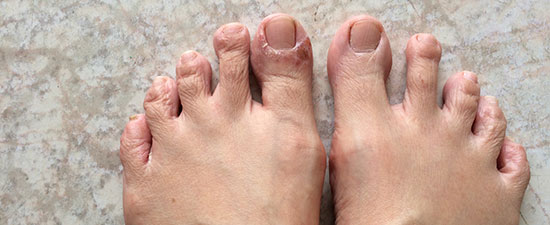
A young Canadian couple is warning anyone planning to travel somewhere tropical after contracting a parasitic infection known as “hookworms.”
Here’s a cautionary tale of a tropical beach vacation that went awry. It’s bound to make your feet feel itchy just reading it – and it’s not for the squeamish.
If you’re still with us, consider yourself warned. Long walks on a tropical beach are so synonymous with romance that it’s almost a cliché. But trouble may be lurking right underfoot on those gorgeous beaches. While on vacation in the Dominican Republic, a Canadian couple took many leisurely barefoot strolls on the beach and ended up contracting parasites in their feet.
An itchy, bumpy rash that only got worse
Katie Stephens, 22, and Eddie Zytner, 25, realized something was wrong midway through their tour of Punta Cana, when their feet became severely itchy. They took the itching in stride, believing they had only picked up some nasty bites from sand flies.
But the itching worsened without mercy. Upon returning home, the couple noticed increased swelling, and clusters of blister-like bumps forming on the front parts of their feet, including on and in between their toes. It took visits to three doctors to finally get a diagnosis. The bumps weren’t bug bites, but cutaneous larva migrans; parasitic hookworms, or nematodes, which burrow beneath the skin.
Stephens posted a warning to Facebook, with pictures of her and her boyfriend’s feet, where you can see the worm-like tracks left by the creepy crawlers.
Hookworm infections spread through contact with soil (or sand) that contains eggs or larvae
The larvae move into the soil after passing through animal feces (just go ahead and let your imagination run wild with that little factoid). The larvae are attracted to heat, salt, and odors characteristic of mammals, so feet are the perfect target for burrowing and hatching.
In the US, it’s usually dogs, cats, and other beasts that have to worry about worms. We don’t see too many instances of human infection on our shores. According to the CDC, you’re more likely to snag some of these parasites in warm, tropical climates, where public sanitation is sub-par.
“In some regions of Africa,” writes neurobiologist Elissa Hallem, “over half of the population is estimated to be infected with at least one species of parasitic nematode.”
The red, bumpy rash the couple developed is called a “creeping eruption”
It usually appears within one to five days after making first contact with the larva. However, the eggs can apparently make themselves right at home before they hatch, and the incubation period could last up to a month.
Treatment and prevention of hookworms
Hookworms can only live for about 6 weeks inside humans, but honestly, who could wait that long? Infections can be treated with oral medications such as ivermectin and albendazole. The drugs essentially starve and paralyze the worms, keeping them from absorbing sugar through the bloodstream. Eventually, they die and are flushed out of the system.
Instead of exposing your feet, a better idea is to wear beach shoes or flip-flops when walking on tropical beaches. Wearing shoes to the beach can help you avoid poop and other hazards, including sharp shells, rocks, or litter. Shoes can also offer you some stability, helping to prevent accidents and injuries while you’re out there enjoying yourself.
This is good information for your next tropical vacation. If your feet get into trouble, let us know; we’re here to help.
The physicians at University Foot and Ankle Institute are leaders in the field of research and treatment of all foot and ankle conditions. Our nationally recognized podiatrists and foot and ankle specialists offer the most advanced foot and ankle care along with the highest success rates in the nation.
For more information or to schedule a consultation, please call (877) 736-6001 or visit us at www.footankleinstitute.com.
At UFAI, we take our patients’ safety seriously. Our clinics’ and surgery centers’ Covid-19 patient safety procedures exceed all CDC recommendations during this coronavirus pandemic. Masks are required in our institutes at all times.
We are conveniently located throughout Southern California and the Los Angeles area. Our doctors are available at locations in or near: Santa Monica, Beverly Hills, West Los Angeles, Manhattan Beach, Northridge, Downtown Los Angeles, Westlake Village, Granada Hills, and Valencia, California.
- Top 10 Non-Surgical Treatments for Morton’s Neuroma - January 20, 2025
- Moore Balance Brace: Enhance Stability and Prevent Falls for Better Mobility - December 16, 2024
- Should I See a Podiatrist or Orthopedist for Foot Pain and Ankle Problems? - December 8, 2024
Leave a Reply